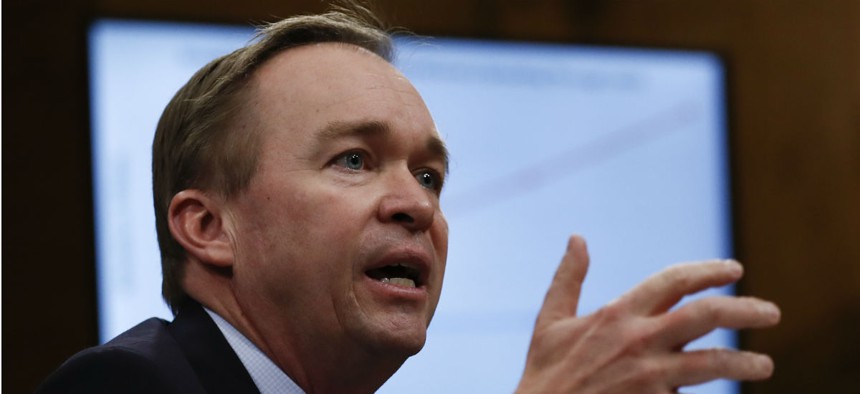
OMB Director Mick Mulvaney said that, “Without additional appropriations, our national security is at risk.” Carolyn Kaster/AP
Trump Requests Dramatic Budget Cuts for the Rest of This Year, Too
$18 billion in domestic agency funding reductions in the remainder of fiscal 2017 would offset border wall, other priorities.
President Trump called for $54 billion in cuts to domestic agencies in his fiscal 2018 budget released Thursday, but the White House was not done in suggesting spending reductions. In a supplemental request to House Speaker Paul Ryan, R-Wis., also sent Thursday, Trump suggested an immediate cut of $18 billion to non-defense discretionary spending to partially offset increases in fiscal 2017 appropriations for other Trump priorities.
The president requested a total of $30 billion extra for the Defense Department -- $24.9 billion for its base budget and $5.1 billion for Overseas Contingency Operations -- to “begin a sustained effort to rebuild the U.S. Armed Forces.” He also asked Congress for an extra $3 billion to fund his executive orders tasking the Homeland Security Department with ramping up border security and immigration enforcement. The increased appropriations would go toward constructing a wall along the U.S.-Mexico border, increasing detention capacity, and completing the initial steps in Trump’s proposed hiring surge at Customs and Border Protection and Immigration and Customs Enforcement.
DHS is currently slated to receive a total of $41.3 billion in fiscal 2017, meaning Trump’s proposal would increase spending at the department by 7 percent with just half the year to spend it. CBP would receive $65 million to “build hiring capacity,” including through recruiting efforts, as part of its plan to eventually onboard 5,000 new Border Patrol agents. ICE would receive $76 million to start hiring its goal of 10,000 new employees. Both agencies have said the process will take several years to fully implement. To support the new onboarding, Trump requested $88 million for various aspects of the Federal Law Enforcement Training Center.
The White House also asked for an immediate influx of $1 billion for design and construction of the first phase of the wall, in addition to $400 million to other border security infrastructure investments. To support increased “detention and removal of illegal aliens,” Trump asked for $1.2 billion total for ICE.
“Without additional appropriations, our national security is at risk,” Office of Management and Budget Director Mick Mulvaney wrote in his recommendation to Trump, who in turn passed it on to Ryan.
The White House did not specify what the $18 billion in cuts -- designed to offset the DHS and half the Defense funding surge -- would target. Congress would likely consider the proposed amendments to current appropriations at the end of April, when the existing continuing resolution for fiscal 2017 is set to expire. Reaching the reductions in just five months would cause significant strain on federal agencies; in March of 2013, the Obama administration was forced to administer a sequestration of about $26 billion. That led agencies to implement furlough plans (most of which were eventually scaled back from initial estimates) and hiring freezes, cut services to taxpayers, and delay planned contracts and investments.
“A cut of that magnitude over a five-month period would be devastating to the agencies’ ability to conduct their day-to-day work,” said Tony Reardon, president of the National Treasury Employees Union.
A Senate Appropriations Committee aide said this week the panel is listening to input from Republicans, Democrats and the Trump administration, and it is making good progress towards completing its work for fiscal 2017. Democrats have threatened to shut down the government if Congress includes funding for Trump’s immigration priorities in fiscal 2017 appropriations. They labeled the ICE hiring surge the creation of a “deportation force” and said it would be “inappropriate” to include such priorities in must-pass spending bills. The American people are not well served by a government shutdown, the Republican committee aide said.
NEXT STORY: Winners and Losers in Trump's Cut-Filled Budget







